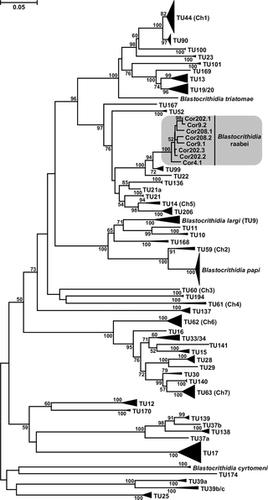Our official English website, www.x-mol.net, welcomes your feedback! (Note: you will need to create a separate account there.)
If host is refractory, insistent parasite goes berserk: Trypanosomatid Blastocrithidia raabei in the dock bug Coreus marginatus.
PLOS ONE ( IF 3.7 ) Pub Date : 2020-01-16 , DOI: 10.1371/journal.pone.0227832 Alexander O Frolov 1 , Marina N Malysheva 1 , Anna I Ganyukova 1 , Viktoria V Spodareva 1, 2 , Jana Králová 2 , Vyacheslav Yurchenko 2, 3 , Alexei Y Kostygov 1, 2
PLOS ONE ( IF 3.7 ) Pub Date : 2020-01-16 , DOI: 10.1371/journal.pone.0227832 Alexander O Frolov 1 , Marina N Malysheva 1 , Anna I Ganyukova 1 , Viktoria V Spodareva 1, 2 , Jana Králová 2 , Vyacheslav Yurchenko 2, 3 , Alexei Y Kostygov 1, 2
Affiliation

|
Here we characterized the development of the trypanosomatid Blastocrithidia raabei in the dock bug Coreus marginatus using light and electron microscopy. This parasite has been previously reported to occur in the host hemolymph, which is rather typical for dixenous trypanosomatids transmitted to a plant or vertebrate with insect's saliva. In addition, C. marginatus has an unusual organization of the intestine, which makes it refractory to microbial infections: two impassable segments isolate the anterior midgut portion responsible for digestion and absorption from the posterior one containing symbiotic bacteria. Our results refuted the possibility of hemolymph infection, but revealed that the refractory nature of the host provokes very aggressive behavior of the parasite and makes its life cycle more complex, reminiscent of that in some dixenous trypanosomatids. In the pre-barrier midgut portion, the epimastigotes of B. raabei attach to the epithelium and multiply similarly to regular insect trypanosomatids. However, when facing the impassable constricted region, the parasites rampage and either fiercely break through the isolating segments or attack the intestinal epithelium in front of the barrier. The cells of the latter group pass to the basal lamina and accumulate there, causing degradation of the epitheliocytes and thus helping the epimastigotes of the former group to advance posteriorly. In the symbiont-containing post-barrier midgut segment, the parasites either attach to bacterial cells and produce cyst-like amastigotes (CLAs) or infect enterocytes. In the rectum, all epimastigotes attach either to the cuticular lining or to each other and form CLAs. We argue that in addition to the specialized life cycle B. raabei possesses functional cell enhancements important either for the successful passage through the intestinal barriers (enlarged rostrum and well-developed Golgi complex) or as food reserves (vacuoles in the posterior end).
中文翻译:

如果宿主是难治性的,则顽固的寄生虫会发疯:码头臭虫Coreus marginatus中的Trypanosomatid Blastocrithidia raabei。
在这里,我们用光镜和电子显微镜表征了在码头臭虫边缘边缘的锥虫Blastocrithidia raabei的发育。先前已报道过这种寄生虫会在宿主的淋巴中发生,这对于二倍体锥虫病是通过昆虫的唾液传播到植物或脊椎动物中的。此外,边缘角。具有肠道的异常组织,使它难以抵抗微生物感染:两个不可逾越的部分将负责消化和吸收的前中肠部分与含有共生细菌的后肠区分开来。我们的结果驳斥了血淋巴感染的可能性,但发现宿主的难治性激发了该寄生虫的攻击性行为,并使其生命周期更加复杂,让人联想到一些双锥锥虫。在屏障前的中肠部分,B。raabei的附鞭毛虫附着在上皮上,并与普通昆虫锥虫一样繁殖。但是,当面对不可逾越的狭窄区域时,寄生虫会横冲直撞,或者猛烈地穿过隔离段,或者攻击屏障前的肠上皮。后一组的细胞传到基底膜并在那里积累,引起上皮细胞的降解,从而帮助前一组的后鞭毛体向后发展。在含有共生体的屏障后中肠段中,寄生虫附着在细菌细胞上并产生囊样变形虫(CLA)或感染肠上皮细胞。在直肠 所有副鞭毛者附着在表皮衬里或彼此附着,形成CLA。我们认为,除了特殊的生命周期,B。raabei还具有功能性细胞增强功能,对于成功通过肠道屏障(增大的讲台和发达的高尔基复合体)或作为食物储备(后部的空泡)都很重要。
更新日期:2020-01-17
中文翻译:

如果宿主是难治性的,则顽固的寄生虫会发疯:码头臭虫Coreus marginatus中的Trypanosomatid Blastocrithidia raabei。
在这里,我们用光镜和电子显微镜表征了在码头臭虫边缘边缘的锥虫Blastocrithidia raabei的发育。先前已报道过这种寄生虫会在宿主的淋巴中发生,这对于二倍体锥虫病是通过昆虫的唾液传播到植物或脊椎动物中的。此外,边缘角。具有肠道的异常组织,使它难以抵抗微生物感染:两个不可逾越的部分将负责消化和吸收的前中肠部分与含有共生细菌的后肠区分开来。我们的结果驳斥了血淋巴感染的可能性,但发现宿主的难治性激发了该寄生虫的攻击性行为,并使其生命周期更加复杂,让人联想到一些双锥锥虫。在屏障前的中肠部分,B。raabei的附鞭毛虫附着在上皮上,并与普通昆虫锥虫一样繁殖。但是,当面对不可逾越的狭窄区域时,寄生虫会横冲直撞,或者猛烈地穿过隔离段,或者攻击屏障前的肠上皮。后一组的细胞传到基底膜并在那里积累,引起上皮细胞的降解,从而帮助前一组的后鞭毛体向后发展。在含有共生体的屏障后中肠段中,寄生虫附着在细菌细胞上并产生囊样变形虫(CLA)或感染肠上皮细胞。在直肠 所有副鞭毛者附着在表皮衬里或彼此附着,形成CLA。我们认为,除了特殊的生命周期,B。raabei还具有功能性细胞增强功能,对于成功通过肠道屏障(增大的讲台和发达的高尔基复合体)或作为食物储备(后部的空泡)都很重要。


























 京公网安备 11010802027423号
京公网安备 11010802027423号